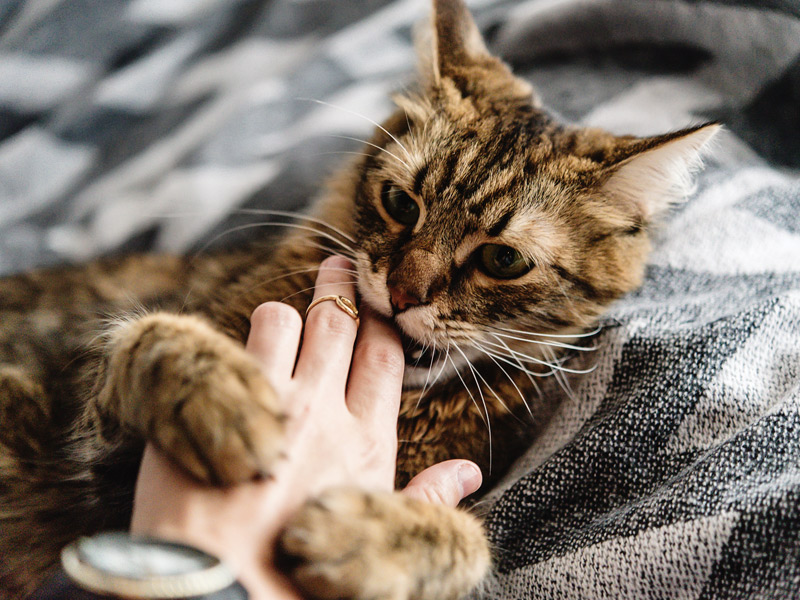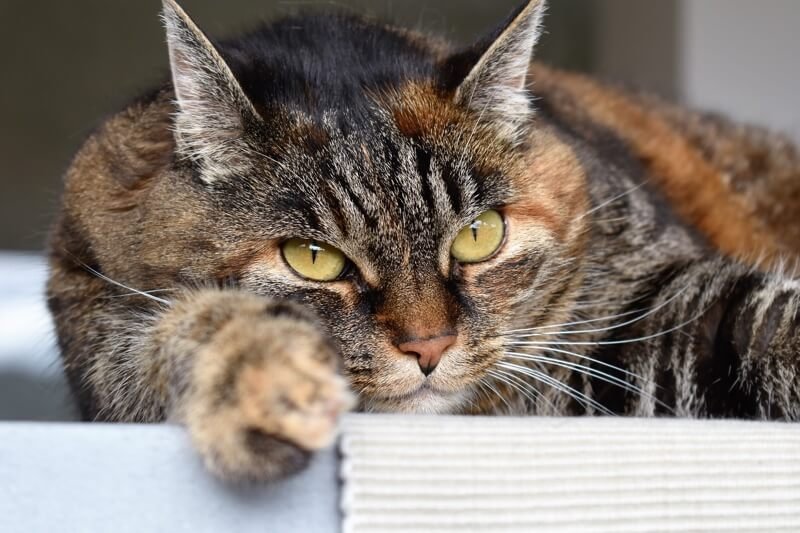To solve behavior problems in cats, reward desirable behaviors with positive reinforcement techniques such as treats or favorite toys. Clicker training and behavior modification techniques can be particularly useful in teaching cats to urinate, defecate, climb, scratch, or perch in appropriate locations.
It’s also important to choose a word and use a firm voice consistently to discipline misbehaving cats. Avoid forcing physical contact or cornering an angry cat, and instead, let them approach you on their terms. Offer slow and deliberate movements, and use soothing tones to calm them down.
It’s essential to address the underlying anxieties and any associated aggressive behaviors when treating feline elimination disorders.

Understanding Common Behavior Problems In Cats
Cats are complex creatures with unique personalities, and sometimes they may exhibit behavior problems that can be challenging for their owners to handle. From aggression to excessive vocalization and obsessive-compulsive licking, it’s important for cat owners to understand these common behavior issues and how to address them effectively. By identifying the signs and implementing appropriate strategies, you can create a harmonious environment for both you and your feline companion. In this article, we will discuss three common behavior problems in cats and provide practical solutions for each.
Identifying Aggressive Behavior
Aggression in cats can manifest in various ways, such as biting, scratching, hissing, or growling. It’s crucial to identify the root cause of aggression to address it effectively. Here are some signs to look out for:
- Unprovoked attacks towards humans or other animals
- Protective behavior over territory or resources
- Excessive play aggression
To manage aggressive behavior in your cat, consider the following:
- Provide a safe and comfortable space for your cat to retreat to when feeling anxious or stressed.
- Engage your cat in constructive play with interactive toys to channel their energy in a positive way.
- Consult with a veterinarian or animal behaviorist for professional guidance and potential medical interventions.
- Consider implementing positive reinforcement training techniques to redirect your cat’s aggressive behaviors.
Dealing With Vocalization Issues
Cats are naturally vocal animals, but excessive or inappropriate vocalization can be problematic for both the cat and its owner. Here are a few vocalization issues commonly observed in cats:
| Issue | Description |
|---|---|
| Excessive Meowing | The cat constantly vocalizes for attention, food, or other needs. |
| Nighttime Crying | The cat becomes vocal during the night, disrupting sleep patterns. |
| Agonistic Vocalizations | Growling, hissing, or yowling during aggressive interactions. |
To manage vocalization issues, try the following:
- Ensure your cat’s basic needs, such as food, water, and a litter box, are met.
- Engage in interactive play sessions to provide mental stimulation and tire out your cat.
- Establish a regular feeding and playtime schedule to create a sense of routine and predictability.
- Provide enriching toys and environmental stimulation to keep your cat mentally engaged.
Managing Obsessive-compulsive Licking
Obsessive-compulsive licking is a behavior problem that can indicate underlying anxiety, discomfort, or boredom in cats. Look out for these signs:
- Excessive and repetitive grooming, leading to hair loss or skin irritation
- Licking non-body objects, such as furniture, blankets, or walls
- Licking certain body parts excessively
To manage obsessive-compulsive licking, consider the following:
- Rule out any underlying medical conditions by consulting a veterinarian.
- Provide environmental enrichment, such as scratching posts, puzzle toys, and hiding spots, to alleviate boredom.
- Redirect your cat’s attention to more appropriate activities by offering interactive play sessions.
- Consider using pheromone sprays or diffusers to create a calming environment for your cat.

Addressing Behavior Problems In Cats
Looking for solutions to behavior problems in cats? Rewarding desirable behaviors and using behavior modification techniques can help address issues like inappropriate urination, scratching, and aggression. Find out more on how to solve these behavior problems in cats.
Identifying Triggers And Avoiding Aggressive Behavior
Addressing behavior problems in cats is essential for creating a harmonious environment for both the cat and its owners. One common issue that cat owners face is aggressive behavior. Aggression in cats can be triggered by various factors, such as fear, stress, or territorial instincts. To address aggressive behavior, it is crucial to identify the triggers and take steps to avoid them.
To identify triggers, closely observe your cat’s behavior and note any patterns or situations that lead to aggression. It could be certain sounds, sights, or interactions with other animals or humans. Once the triggers are identified, you can then work on avoiding them.
Creating a safe and comfortable environment for your cat is key to preventing aggressive behavior. Provide hiding spots, such as cat trees or beds, where your cat can retreat to when feeling threatened. Keep the areas where your cat spends most of its time calm and quiet. Avoid loud noises or sudden movements that can startle your cat.
Additionally, if you have multiple cats, ensure that they have enough space and resources, such as food bowls, litter boxes, and scratching posts, to avoid competition and territorial disputes.
Understanding And Managing Vocalization Issues
Another behavior problem that cat owners may encounter is excessive vocalization. Cats communicate through various vocalizations, such as meowing, purring, or hissing. While some level of vocalization is normal, excessive meowing, especially at inappropriate times, can be a sign of an underlying issue.
To understand and manage vocalization issues, it is necessary to determine the cause of the excessive meowing. Are they hungry, bored, anxious, or seeking attention? Once the cause is identified, you can take appropriate steps to address it.
For instance, if your cat meows for attention, ensure that you spend quality time playing and bonding with them regularly. Provide interactive toys and engage in interactive play to keep them mentally stimulated. If your cat meows due to hunger, ensure they have scheduled mealtimes and are fed a balanced diet.
If your cat’s excessive vocalization persists or is accompanied by other concerning symptoms, it is advisable to consult a veterinarian to rule out any underlying medical conditions.
Breaking The Cycle Of Obsessive-compulsive Licking
Obsessive-compulsive licking is another behavior issue that some cats may develop. This behavior can manifest as excessive grooming, excessive licking of surfaces, or even themselves to the point of causing harm.
To break the cycle of obsessive-compulsive licking, it is essential to address any underlying causes and provide alternative outlets for the cat’s energy and focus.
Firstly, consult with a veterinarian to rule out any potential medical causes for the behavior. Once medical causes are ruled out, you can focus on implementing behavior modification techniques.
One effective strategy is to provide environmental enrichment and mental stimulation for your cat. This can include interactive toys, puzzle feeders, and vertical spaces for climbing and exploration.
Redirect your cat’s attention and energy towards positive activities, such as play sessions with interactive toys or engaging in training sessions using clicker training techniques. Regular play and mental stimulation will not only help decrease obsessive licking but also improve overall wellbeing.
Seeking Professional Help For Cat Behavior Problems
Cat behavior problems can be challenging to handle on your own. If you have tried various strategies and nothing seems to be working, seeking professional help can be beneficial. Professional assistance can provide you with expert guidance tailored to your cat’s specific behavior issues.
Consulting With A Certified Animal Behaviorist
One option for seeking professional help is consulting with a certified animal behaviorist. These professionals have extensive knowledge and experience in understanding animal behavior, including cats. They can assess your cat’s behavior problems, identify underlying causes, and provide you with a comprehensive behavior modification plan.
Working With A Veterinarian
Your veterinarian can also be a valuable resource when it comes to solving behavior problems in cats. They can rule out any underlying medical conditions that may be contributing to your cat’s behavior. Additionally, veterinarians often have training in animal behavior and can provide guidance on behavior modification techniques or recommend medications if necessary.
Finding Support And Advice Online
If professional help in person is not feasible for you, there are online resources available to provide support and advice. Numerous websites, forums, and social media groups are dedicated to cat behavior and can offer guidance from experienced cat owners and experts. However, it is essential to remember that not all online advice is reliable, so be sure to seek information from reputable sources.
In conclusion, seeking professional help is a valuable step in solving behavior problems in cats. Consulting with a certified animal behaviorist or working with a veterinarian can provide you with expert guidance tailored to your cat’s specific needs. Alternatively, finding support and advice online can also be helpful. Remember to prioritize your cat’s well-being and consult with a professional to ensure the best outcome for both you and your feline friend.
:strip_icc()/portrait-of-tabby-cat-biting-and-scratching-owners-hand-556454041-57c48eb35f9b5855e5d9d6f0.jpg)
Frequently Asked Questions Of How To Solve Behavior Problems In Cats
How Do You Fix Behavioral Problems In Cats?
To fix behavioral problems in cats, use positive reinforcement techniques like rewarding good behavior with treats or toys. Clicker training and behavior modification techniques can also help. Avoid forcing physical contact and let the cat approach you on their terms.
Use soothing tones and speak softly to calm an angry cat. Look for signs of stress, such as toileting around the house or excessive scratching, and address any underlying anxieties.
How Do You Discipline A Misbehaving Cat?
To discipline a misbehaving cat, choose a word like “no” or “stop” and say it firmly every time they act out. Be consistent and use a firm voice to signal that you don’t approve of their behavior. This helps them make the connection and learn what is not acceptable.
How Do You Calm An Angry Cat?
To calm an angry cat, avoid forcing contact or cornering them. Let them approach you on their terms. Use slow movements and soothing tones.
Am I Stressing My Cat Out?
To determine if you’re stressing out your cat, watch for signs like toileting around the house, excessive spraying, scratching, sleeping under the bed, sweaty feet, and displacement activities. If you notice these signs, it’s important to address the underlying anxieties and behaviors that may be causing the stress.
Conclusion
Addressing behavior problems in cats requires a combination of techniques and approaches. By rewarding desirable behaviors through positive reinforcement and utilizing behavior modification techniques, you can effectively teach your cat appropriate behaviors. Discipline should be consistent and focused on redirecting unwanted behaviors.
Additionally, it is important to create a calm and stress-free environment for your cat. Consulting with a veterinarian and addressing any underlying anxieties or medical issues can also be beneficial. With patience, consistency, and understanding, you can successfully solve behavior problems in your feline companion and foster a harmonious relationship.


